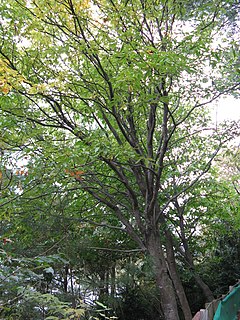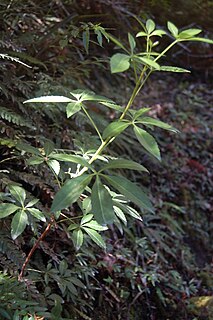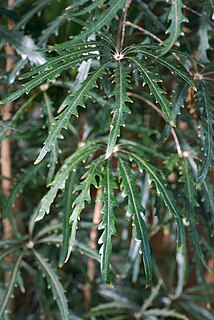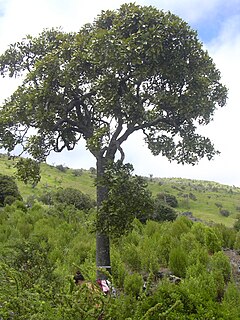
GastoniaCommerson ex Lamarck is a formerly accepted genus of flowering plants in the ivy and ginseng family, Araliaceae. It had been known as an unnatural group, but was recognized as late as 2010, when its nine species were distributed to four different subgenera of the large genus Polyscias. Because the genus Gastonia is now obsolete, its species are herein referred to by their names in Polyscias.

Schefflera is a genus of flowering plants in the family Araliaceae. With an estimated 600–900 species, the genus represents about half of its family. The plants are trees, shrubs or lianas, growing 4–20 metres (13–66 ft) tall, with woody stems, the absence of articulated pedicels and armaments, and palmately compound leaves.
Arthrophyllum is a defunct genus of flowering plants in the family Araliaceae. It was recognized by most authors until 2010, when all of its 30 species were "sunk" into ''Polyscias'' subgenus Arthrophyllum.
Cuphocarpus is an obsolete genus of flowering plants in the family Araliaceae. Mabberley (2008) treated it as a synonym of Polyscias, but other authors still recognized it at that time. In 2010, in a phylogenetic analysis of DNA sequences, it was shown that Cuphocarpus was biphyletic and embedded in the large genus Polyscias. In an accompanying paper, Polyscias was divided into 11 subgenera, with seven species left incertae sedis.

Gamblea is a genus of plants of the family Araliaceae, comprising four species. It originally comprised a single species, Gamblea ciliata, which is found in India.

Raukaua is a genus of flowering plants in the family Araliaceae. It has an austral distribution, being indigenous to southern Argentina and Chile, as well as New Zealand and the island of Tasmania.

Reynoldsia is an obsolete genus of flowering plants in the ivy family, Araliaceae. In 2003, Kew Gardens published a checklist for Araliaceae, in which eight species were recognized for Reynoldsia: four from Samoa, two from Tahiti, one from the Marquesas, and one from Hawaii. In 2010, a phylogenetic comparison of DNA data showed that Reynoldsia was polyphyletic, consisting of two groups that are not each other's closest relatives. In a companion paper, three of the species were "sunk" into synonymy with others, reducing the number of species to five. All species that were formerly in Reynoldsia are now in ''Polyscias'' subgenus Tetraplasandra, a subgenus of 21 species indigenous to Malesia and Pacific islands.

Plerandra is a genus of flowering plants in the family Araliaceae that has long been considered a synonym of Schefflera, which has been a polyphyletic group.

Tetraplasandra is an obsolete genus of flowering plants in the ivy family, Araliaceae. They are small to medium trees, of mesic to wet forests.

Turraea is a genus of plants in the family Meliaceae, native throughout of Old World Tropics. In the countries of Angola, Australia Benin, Botswana, Burundi, Cabinda, Cambodia, Cameroon, Caprivi Strip, Central African Republic, China (south-east), Comoros, Congo, Equatorial Guinea, Eritrea, Ethiopia, Gabon, Ghana, Gulf of Guinea Is., Hainan, Ivory Coast, Jawa, Kenya, Laos, Lesser Sunda Islands., Liberia, Madagascar, Malawi, Mauritius, Mozambique, New Guinea, Nigeria, Philippines, Rodrigues, Rwanda, Réunion, Saudi Arabia, Sierra Leone, Socotra, Somalia, South Africa, Sudan, Swaziland, Tanzania, Thailand, Togo, Uganda, Vietnam, Yemen, Zambia, Zaïre and Zimbabwe.
Pierre Cusson (1727–1783), anglicised as Peter Cusson, was a French botanist who specialised in Umbelliferae. As a young man he travelled through Majorca, Spain and the Pyrenees, building up an excellent specimen collection of the flora of those regions. Shortly after his return to his home in Montpellier, an elderly female relative with whom he lived cleaned his study in his absence, discarding his entire collection.
Neocussonia vantsilana is a species of flowering plant endemic to Madagascar.
Jacobsenia is a genus of flowering plants belonging to the family Aizoaceae.
Lefebvrea is a genus of flowering plants belonging to the family Apiaceae.
Leplaea is a genus of flowering plants belonging to the family Meliaceae.
Moquiniella is a monotypic genus of flowering plants belonging to the family Loranthaceae. It only contains one known species, Moquiniella rubra(A.Spreng.) Balle
Mossia is a monotypic genus of flowering plants belonging to the family Aizoaceae. It only contains one known species, Mossia intervallaris(L.Bolus) N.E.Br.
Gambeya is a genus of flowering plants belonging to the family Sapotaceae.
Marlothistella is a genus of flowering plants belonging to the family Aizoaceae.
Neesenbeckia is a monotypic genus of flowering plants belonging to the family Cyperaceae. The only species is Neesenbeckia punctoria(Vahl) Levyns.







